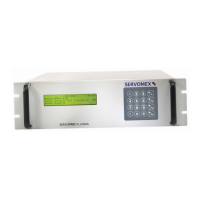User Manual SERVOPRO Plasma Trace N
2
Analyzer
5.0 DESCRIPTION
12
5.4 Analysis section
The sample gas, which at atmospheric pressure, flows through a proprietary design; a pure quartz
cell is submitted to a high-frequency, high-intensity electromagnetic field.
The SERVOPRO PLASMA Analyzer is based on a spectroscopic emission cell, which in itself is
not a new technique. On the other hand, the characteristics which make this system stable and
selective are the frequency, the intensity, the regulation, as well as the coupling technique and
focusing (stabilizing) electrodes used to keep the plasma stable.
Under these conditions, the plasma becomes the center of a luminous phenomenon
(electroluminescence). In fact, the plasma is electromagnetically induced. Plasma is a collection
of charged particles; In this case, the plasma consists of a stream of sample gas. This process
being an emission technique, it is very useful for quantitative analysis. This is not a new
technique. These recent advances make the development of new instruments based on plasma
technology easier; this without the cost normally associated with this category of analytical
instruments.
Once the sample gas is ionized (charged), many spectral lines are emitted.
Here, we think a few words regarding the technique used to create the plasma are necessary.
There are many ways of producing light from a gas stream for analytical purposes. The
electroluminescence phenomenon includes luminescence from all kinds of electrical discharges,
such as sparks, arcs or tubes of different kinds, operating on direct or alternating current of low
or high frequency. Recently, some experiments were conducted in the microwave range by
surface-wave-induced plasma.
Excitation, in these cases, results mostly from electron or ion collisions; that is, the kinetic
energy of electrons or ions accelerated in an electric field in which the atoms or molecules of a
gas are subjected that causes the emission of light.
By any of the above mentioned methods, a characteristic emission spectra can be obtained for the
plasma gas and each substance in it. The emission usually varies for a given substance,
depending on the mode of excitation.
We developed our plasma generator and plasma cell in such a way as to minimize the heat
generation inside the cell to get a clear spectral line for the substance of interest, i.e. nitrogen.
Once the intense line is identified, we must use a system to filter it out. In our case, instead of
using a defraction grating, prism or tunable filter, we use an custom made optical filter with a
special coating that lessens background noise considerably and reduces spectral interference.
This filter shows an exceptional blocking range. The filter's main characteristic is its great
stability: temperature and humidity and time will not affect its performance. The filter is coupled
with a special lens that focuses the optical beam.

